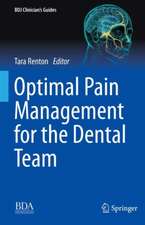Basal Implantology
Editat de Gérard M. Scorteccien Limba Engleză Hardback – 9 iul 2019
Preț: 975.47 lei
Preț vechi: 1026.82 lei
-5% Nou
Puncte Express: 1463
Preț estimativ în valută:
186.65€ • 194.88$ • 154.48£
186.65€ • 194.88$ • 154.48£
Carte tipărită la comandă
Livrare economică 01-07 aprilie
Preluare comenzi: 021 569.72.76
Specificații
ISBN-13: 9783319448718
ISBN-10: 3319448714
Pagini: 613
Ilustrații: XII, 398 p. 613 illus., 418 illus. in color.
Dimensiuni: 155 x 235 x 24 mm
Greutate: 0.68 kg
Ediția:1st ed. 2019
Editura: Springer International Publishing
Colecția Springer
Locul publicării:Cham, Switzerland
ISBN-10: 3319448714
Pagini: 613
Ilustrații: XII, 398 p. 613 illus., 418 illus. in color.
Dimensiuni: 155 x 235 x 24 mm
Greutate: 0.68 kg
Ediția:1st ed. 2019
Editura: Springer International Publishing
Colecția Springer
Locul publicării:Cham, Switzerland
Cuprins
Basic Principles of Basal Implantology: Definition and Goals of Basal Implantology.- Principles of Initial Bone Bed Preparation.- The Stability Principle.- Biomechanics.- 3D Implant Planning for Basal Implantology.- Basal Implantology Techniques. Step by Step Guide to Basal Implantology: Patient Selection and Treatment Planning.- Priorities in Extreme Situations.- Atraumatic Operating Techniques.- Post-Operative Follow-up. Clinical Situations: Type of Edentulism.- Single Tooth Replacement with Basal Implants.- Multiple Tooth Replacements With Basal Implants.- Complete Edentulism; the Atrophic Maxilla and/or Mandible. Maintenance, Long-Term Follow-up and Correction of Problems: Maintenance.- Long-Term Follow-up.- Correction of Problems.
Recenzii
“The book is a practical guide for implant surgeons and helps them find simple solutions to complex and highly demanding clinical situations. To facilitate understanding it is abundantly illustrated with pictures from clinical cases, CT’s and radiographs.” (Marian-Vladimir, Stomatology EDU Journal, Vol. 7 (2), 2020)
Notă biografică
Gérard M. Scortecci, DDS, PhD, is Scientific Director of the Postgraduate Basal Implantology Program at the University of Nice-Sophia Antipolis School of Medicine, France, Clinical Professor of Periodontology at the University of Southern California, USA, and Visiting Professor, New York University. He was President of the International Congress of Oral Implantologists from 2013 to 2017. Dr. Scortecci is a Fellow of the American College of Dentists (FACD) and the International College of Dentists (FICD) and a Diplomate of the International College of Oral Implantologists (FICOI). He has acted as an official examiner for competency in oral implantology (DGOI) and as a legal expert in odonto-stomatology. Dr. Scortecci has been a nominated expert for the French delegation to the International Standards Organization (ISO) for dental implants. He is the author of more than 200 publications in French and English, including 14 papers in peer-reviewed journals cited in PubMed and the bookImplants and Restorative Dentistry (Martin Dunitz, London, 2000).
Textul de pe ultima copertă
This manual will help oral implantologists to understand the principles that underlie the use of basal implants as a means to provide simple solutions to complex and highly demanding clinical situations without the need for prior bone grafting. It will also serve as a richly illustrated practical guide to application of the technique. The book is in three parts, the first of which discusses basic principles and related themes, including osteogenesis, osseointegration, cortical anchorage stability, biomechanics, surgical techniques, and basal implant prosthodontics. Step-by-step guidance is then offered on the application of these principles, focusing on operating techniques, 3D treatment planning, transitional and final screw-secured prostheses, and postoperative follow-up. The third part of the book addresses a wide range of clinical situations that can be treated by basal implantology, with particular attention to the treatment of high, thin alveolar ridges and the atrophic maxilla and mandible and to the correction of previous implant failures. Potential complications and postimplantation neuropathies are also discussed, with guidance on their management.
Caracteristici
Explains the principles that underlie the use of basal implants Offers step-by-step guidance on technique Covers a wide range of clinical situations













